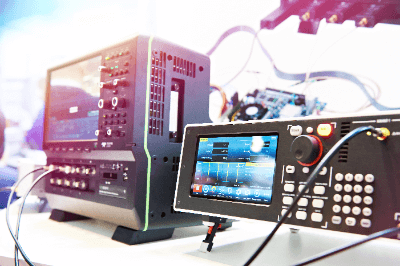What Is a Pulse Generator?
 A pulse generator is a device that generates rapidly occurring and converging electrical signals called pulses.
A pulse generator is a device that generates rapidly occurring and converging electrical signals called pulses.
Pulse generators can adjust pulse frequency, pulse width, voltage level, and timing delay. Pulse generators include pulse delay generators, burst generators, and gate generators.
Uses of Pulse Generators
Pulse generators are used in a wide range of applications, from industrial to consumer products.
Familiar products include medical pacemakers and automobile engines. These applications take advantage of the pulse generator’s ability to input pulses of electrical signals at high speed.
Other applications include strobe control and observation of high-speed moving objects.
Another common use is as a power source for semiconductor lasers (LDs). A semiconductor laser emits light when electricity exceeding a threshold value is input. A pulse generator is necessary when the laser light is pulsed. Pulsed lasers are mainly used for laser processing and signal transmission.
Principle of a Pulse Generators
To generate pulses with a pulse generator, a commercial alternating current must be converted to a direct current by a transistor or other means. In addition, the DC current is converted to a higher voltage by means of a capacitor or other storage device.
The most common method for generating pulse current from high-voltage current is to use a concentrated constant circuit. In a concentrated constant circuit, a gap switch is used. The gap switch allows the charge to accumulate in the capacitor until a threshold value is reached and then releases the charge when the threshold value is reached. The repetition of this process generates a pulse.
Types of Pulse Generators
There are several types of pulse generators depending on their application and function. Therefore, it is necessary to select the appropriate one for each application. The three main types of pulse generators used are pulse delay generators, burst generators, and gate generators.
1. Pulse Delay Generator
A time delay can be applied to the pulse oscillation. Also, the timing of the light-receiving device can be matched to the laser oscillation.
2. Burst Generator
The burst trigger is used as the criterion for judging whether the gate is valid or invalid. Therefore, regardless of whether the reference signal is input or not, no pulse is output unless the burst trigger is input to the generator. It is often used for the evaluation of wireless terminals.
3. Gate Generator
A pulse generator whose output pulses can be controlled by a gate trigger. Pulses are output when a reference signal is input during the gate trigger input. In the case of burst triggering, the gate generator will accept all subsequent reference signals that are input once, but will not accept a reference signal if the gate trigger is disabled.
Other Information on Pulse Generators
Price of Pulse Generators
Pulse generators are expensive and are a fixed asset when purchased. Besides, their use is often temporary, unless they are built internally for processing machines.
Therefore, they are often procured through rental or lease.
Prices range widely from 300 to 6000 USD (monthly) depending on performance. Some high-performance pulse generators made by major U.K. manufacturers can cost 7500 to
40,000 USD when purchased.